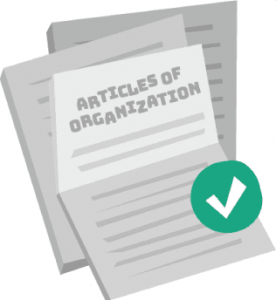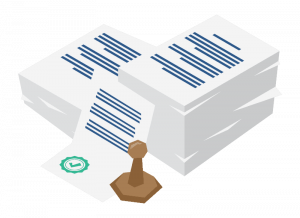How to Start a Business in South Dakota
How do you start a business in South Dakota? The quick answer: by selling services or products. Then, you’ll be a sole proprietor in South Dakota. And, with no corporate, individual, business inventory, or personal property taxes, you’ll be able to retain more of your hard-earned money! Ka-ching! But what about asset protection? After all, you need to protect your money. We’re here to make sure you understand everything you need to know about operating a business in South Dakota.
Ready to Start a Business in South Dakota?
Let's Get You Started
Pick an Entity Type

Name Your Business

File Formation Paperwork

Draft Internal Records

Get South Dakota Business Licenses

Organize Your Money

Get Business Insurance

Understand Your Tax Burden

Build Your Business Website

File a South Dakota Annual Report

Apply for Trademarks

1. Pick an Entity Type
Sole proprietorships are the easiest business entity to start in South Dakota. After sole proprietorships, general partnerships are the second easiest to form and could be considered similar to sole proprietorships, except they are formed with two or more people.
Unfortunately, a sole proprietorship or general partnership don’t provide you with liability protection. Without liability protection, there is no distinction between you and your business. And without a distinction, you will be held responsible for all business-related debts and legal issues. If you want liability protection, you’ll want to form either a limited liability company or a corporation.
South Dakota Limited Liability Company (LLC)
A simple business entity that still offers liability protection is a limited liability company or LLC. They have a flexible management structure and can choose to maintain their default tax status or be taxed as a corporation. Unlike corporations, which we’ll cover next, LLCs aren’t held to as many state regulations and close oversight. To start a South Dakota LLC, you’ll need to file paperwork with the Secretary of State.
South Dakota corporation
South Dakota corporations are the most complex business entity you can form. Since South Dakota recognizes corporations as individual entities, corporations must appoint a board of directors and offer stock. To form a South Dakota corporation, you’ll need to file paperwork with the South Dakota Secretary of State.
Yes! A one-person LLC is called a single-member LLC. Single-member LLCs are one of the most common kinds of businesses in the country. For the most part, single-member LLCs are just like multi-member LLCs, but there are some slight differences in how they file taxes and protect personal assets.
Read all about Single-Member LLCs.
In South Dakota, you can start a South Dakota nonprofit if your business’s aim is to benefit the needs of a specific group or the general public. Like the name states, nonprofits in South Dakota are not formed for making a profit as their primary goal. Nonprofits in South Dakota can be formed with three or more people and by filing Articles of Incorporation ($30) with the South Dakota Secretary of State.
Want to learn more? Check out our Nonprofit Guide.

2. Name Your Business
Naming a business in South Dakota requires following specific statues for your entity. However, as a sole proprietor or general partnership, your business name will be your human name—unless you get a DBA.
For LLCs and corporations, you’ll need a business name that meets South Dakota’s requirements. Your business’s name must:
- Use an appropriate identifier, like “LLC”, “L.L.C” for a limited liability company or “Inc.”, “Incorporated” for a corporation
- Be unique in the state of South Dakota
Find out if your desired name is available in South Dakota by searching the South Dakota Business Name Availability database.
Yes. You can file forms with the Secretary of State to reserve your business name for 120 days if you’re waiting to form your business. Life happens. We get that starting a business takes time from creation to formation. And so does South Dakota.
If you are reserving a name for a limited liability company in South Dakota, you’ll need to file the Application for Reservation of Name Limited Liability Company ($25). If you’re reserving a name for a corporation (excluding nonprofits), you’ll need to file the Application for Reservation of Name Business Corporation ($25).
A DBA (doing business as) is any name your business uses other than its legal name. Your business’s legal name is the name you have listed on your business formation forms. On the other hand, if you’re a sole proprietor or general partnership, your business’s legal name will be your name. All businesses in South Dakota must do business under their legal name—unless you get a DBA.
To file a DBA in South Dakota, you’ll use South Dakota’s DBA registration page. The filing fee is $10, and you must renew every five years if you want to continue doing business under that DBA.
It’s a good idea to check with the US Patent and Trademark Office (USPTO) to make sure your business name hasn’t been trademarked by someone else. If it has, and you use it anyway, there’s a chance that the business could come after you for infringement.

3. File Formation Paperwork
To form a South Dakota LLC or corporation, you’ll need to file paperwork with the South Dakota Secretary of State.
- To form a South Dakota LLC, file South Dakota Articles of Organization
- To start a South Dakota corporation, file South Dakota Articles of Incorporation
You’ll need to list a South Dakota registered agent on these forms who will handle your legal mail.
Note: This information is all available through the South Dakota Business Information Search. Anyone with your business’s name can look up your home address, name, and any other personal information you list.
A registered agent is a person or entity responsible for accepting legal mail for your business. Your registered agent is required to have a physical address in South Dakota, where they are present during regular business hours to accept your legal mail. The problem many business owners face is that their business often takes them away from their regular address. Having a registered agent like Northwest, allows you the freedom to run your business knowing you don’t have to be tied to one location waiting to accept mail.
The best way to avoid having to list your private information is to hire a registered agent who will list their name and address instead of yours. (Hint: we do that!) Keep in mind, however, that if your LLC is manager-managed, you will be required to list the names and addresses of each of your initial managers.

4. Draft Internal Records
So far in this guide, we’ve dealt with public forms that you’ve had to file with the South Dakota Division of Corporations. Now, it’s time to organize your internal records. These are the documents your business will keep on record within your company.
Though these documents are internal, you’ll likely need to show them to third parties like the bank or—if you start a nonprofit—the IRS.
Here are the major internal documents you need to organize for LLCs and corporations:
South Dakota LLC Operating Agreement
This is your LLC’s rule book. It defines how your LLC will do things like make decisions, distribute money, manage operations, and appoint officers. Your operating agreement plans for every big picture scenario your LLC is likely (or unlikely) to face, including dissolution.
Drafting an operating agreement is hard, and the internet is full of shabby templates that have been copy and pasted from who knows where. So we had our attorneys draft a South Dakota LLC Operating Agreement template that you can use as a solid foundation.
South Dakota Corporate Bylaws
Bylaws are the rules your corporation will adopt and follow internally. Bylaws detail how your corporation will appoint directors and officers, hold shareholder and board meetings, and handle emergencies, among other things. Unlike operating agreements, corporate bylaws are required by law in South Dakota (see SD Codified L § 47-1A-206).
As with operating agreements, you can find plenty of bylaw templates online. But bylaws are pretty serious, so you don’t want to just use the first template you come across. Our attorneys drafted a South Dakota Corporate Bylaws template you can use to get started.
Starting a nonprofit? We also have South Dakota nonprofit bylaws.

5. Get South Dakota Business Licenses
Before you can start doing business legally in South Dakota, you’ll likely need to get a business license. In South Dakota, the Department of Revenue requires any business with a physical presence in South Dakota (including sole proprietors) to have a license to collect sales tax. Some businesses will need additional licenses. To help you sort out what you’ll need, we go over a few common licenses required in South Dakota below.
South Dakota State Tax License
The South Dakota Department of Revenue states any business conducting transactions related to the sale of personal property, products transferred electronically, or services must be licensed to collect sales tax. If your business doesn’t have a physical address in South Dakota, you don’t need a license. Unless your business’s gross revenue from South Dakota goes over $100,000 or you’ve made over 200 separate deliveries into South Dakota.
Professional Business Licenses
Are you a licensed nurse or social worker in South Dakota, looking to start your business? Then, you (along other professions that require special education or training) will need to get additional South Dakota licensing through the South Dakota Department of Labor & Regulation and with the Department of Social Services and the Department of Health. Check out the South Dakota Department of Labor & Regulation for the list of all professional licenses and the filings needed.
Local Business Licenses
Regardless of where your business is located, you’ll still need to check your local jurisdiction’s licensing requirements. For example, in Sioux Falls, South Dakota, auctioneers are required to obtain an Auction Sale of Jewelry License. And in Aberdeen, South Dakota, home daycare providers must get licensed from the city. So, you’ll want to make sure you’re compliment with your city or county.
Learn more about How to Get a Business License.
You’ll apply for your tax license using the South Dakota online Tax Licensing Application. In addition to basic information about your business, you’ll also need to provide your EIN or SSN, DBA (if applicable), and your business’s primary mailing address.
There is currently no filing fee associated with the sales tax license. Once your application is submitted, it will take the South Dakota Department of Revenue about one week to process your information.
To get a professional license in South Dakota, head over to the South Dakota Department of Labor & Regulation. Each licensing board will have its own requirements and fees. For example, the South Dakota Board of Accountancy charges $25 or $50 for an initial application—depending on when in the year you are filing.
South Dakota’s local business licensing procedures are governed by the local jurisdiction where your business is located. For example, in Sioux Falls, motion picture theater owners must apply for a Motion Picture Theater license and pay an annual fee for fire and health inspections.

6. Organize Your Money
The liability protection you get from forming an LLC or corporation is only as strong as the separation between you and your business. At a minimum, you’ll need to open a bank account for your business. And if you’re going to hire employees, you’ll need to tackle payroll, too.
Open a Business Bank Account
To keep your business spending separate from your personal spending, you’ll need to open a business bank account. If you don’t, a court could find that your business is not actually separate from you, the owner, under the Alter Ego Doctrine. Also known as piercing the corporate veil, this is the outcome when a judge finds that a company is not a separate entity but rather an alter ego of the owner. If this ever happens, you could lose your limited liability status.
Opening a business bank account as a sole proprietor is important, too. Though sole proprietors and general partnerships have no limited liability status to protect, both will benefit from organizing their business finances come tax season.
If you’ve formed an LLC or corporation, you will need to provide the bank with your formation documents, operating agreement or corporate bylaws, EIN, and in some cases, a Corporate Resolution to Open a Bank Account or LLC Resolution to Open a Bank Account.
Probably. Payment processors require you to provide them with a bank account. This is where they’ll deposit funds from transactions. Most of the time, this needs to be a business bank account.
Some payment processors may let you get away with listing a personal bank account, but it’s not a great idea. Mixing your business finances with your personal finances erodes the separation between you and your business, weakening your liability protection. It also turns tax season into a nightmare.
Learn more about Payment Processing.
Set up Payroll
One of South Dakota’s biggest perks for small business owners like yourself is their lack of income tax. No income tax means less forms and calculations for you if you decide to hire employees or independent contractors. To do so, you’ll need to:
- get an EIN
- register for a South Dakota Reemployment Assistance Tax Account Number
- register with the South Dakota Department of Labor & Regulation
- determine whether you’re hiring employees or independent contractors
- prepare the forms your employees will fill out
- choose a payroll service or software
- decide on a payroll schedule
Setting up payroll in South Dakota doesn’t have to be complicated. To help you along the way, select a reliable and secure payroll service or software that will automatically withhold payroll taxes, file state and federal returns, and pay your employees either by check or direct deposit
Your new employees will need to fill out a W-4 to determine how much you’ll withhold and an I-9 to verify that the employee is eligible to work in the US.
An independent contractor is self-employed—how they complete their work is not directly controlled by an employer. An independent contractor may perform the same kind of work for other businesses, and can do the work when and how they choose.
It’s important to understand the difference between an independent contractor and an employee. That’s because for employees, you’ll need to withhold and pay income, social security, and Medicare taxes. Independent contractors pay these taxes on their own.
An employee, on the other hand, performs their work how and when their employer chooses.
If you’re unsure, you can file Form SS-8 with the IRS and let them decide.
Learn everything you need to know about hiring independent contractors.
To get a South Dakota Reemployment Assistance Tax Account Number, either fill out the Employer Registration Form or register online through the South Dakota Department of Labor & Regulation.

7. Get Business Insurance
Forming an LLC or corporation protects your personal assets. But if anything disastrous befalls your business—like a lawsuit, burglary, flood, or fire—your business is on the hook to pay. Business insurance can help cover the costs.
South Dakota does not require every business to have business insurance, but depending on what you’ll be doing, you may want to make sure you and your business are insured.
Here’s what you need to know:
Workers’ Compensation Insurance
South Dakota doesn’t have a law requiring employers to have workers’ compensation insurance. However, you may want to get workers’ insurance to avoid dealing with being sued by injured employees. Without the insurance, you’re liable for any injuries sustained by your employees while performing their jobs.
Liability Insurance
This covers the costs of claims against your business for injuries or damages to the property of others, like clients or customers. This includes medical expenses, legal fees, settlements, and judgments. Whether or not you need it depends on whether your business is likely to be sued and how many assets your business needs to protect. If it’s just you and your computer in your basement, you might feel comfortable skipping liability insurance. Or maybe you won’t. Beyond general liability insurance, you can purchase or add on more specific types, like professional, cyber, commercial, home-based business, or product liability insurance.
No. South Dakota does not require employers to purchase or have workers’ compensation insurance. Though it is a great idea to get workers insurance to avoid any mishaps.
Probably. That’s because you can’t count on your homeowners’ or renters’ insurance policy to cover damages related to your business. Most insurance companies offer a home-based business insurance plan.

8. Understand Your Tax Burden
South Dakota has no corporate, individual, business inventory, or personal property taxes. Having limited taxes to pay, makes South Dakota a top state to form a business in. But your tax burden isn’t determined by the state alone. You’ll also have federal, state, and local taxes to consider.
Federal Taxes
- LLCs. Single-member LLC? By default, you’re taxed similar to a sole proprietor. More than one LLC owner? You’re taxed as a general partnership. Either way, your default tax status is “pass-through,” which means you don’t pay corporate taxes. Instead, your LLC’s owners report profits and losses on their personal tax returns. Good news: because there’s no state income tax in South Dakota, you’ll only have to pay the 15.3% federal self-employment tax rate. An LLC can file paperwork with the IRS to be taxed as an S-Corp or C-Corp instead.
- Corporations. Corporations are taxed as C-Corps by default. This means that corporations pay the 21% federal corporate tax rate and no corporate tax in South Dakota.
To pay your federal taxes (and take a good deal of other steps required to start a business), you’ll need to get an Employer Identification Number (EIN). You can apply for one with the IRS or hire us to get one for you.
If you’re operating a sole proprietorship or single-member LLC that doesn’t employ anyone else and you don’t need to file excise or pension plan returns, you don’t legally need an EIN.
However, you can still get one—and you probably should. Otherwise, you’ll have to use your own social security number to do business. Plus, you’ll likely need an EIN to open a business bank account.
To get an EIN, you can either apply online or file form SS-4 by mail with the IRS. Getting an EIN is free.
Check out our guide to applying for an EIN.
An S-Corporation is a federal tax election. Registered business entities like LLCs and corporations start out with a default tax status, but can file paperwork with the IRS to be taxed as an S-Corp. Like LLCs, S-Corps are taxed as pass-through entities. Like corporations, S-Corps can make distributions that aren’t subject to the 15.3% self-employment tax.
Learn more about the S-Corp tax election.
A C-corporation is the default federal tax election assigned to corporations. Most corporations are taxed as C-Corps, but LLCs can also apply for C-Corp tax designation by filing paperwork with the IRS. C-corps file federal corporate income taxes and state corporate income taxes (in South Dakota, there is no corporate tax!). C-corps can pay their shareholders in distributions, and the shareholders report those profits on their personal tax returns.
Learn more about the C-Corp tax election.
Local South Dakota Business Taxes
While there may be low to no taxes on the corporate and high level, but there are still local taxes to take into account. South Dakota’s local business taxes are municipal sales tax (up to 2%), use tax, and gross receipts tax (1%).

9. Build Your Business Website
If you want South Dakotans to find your business, they have to be able to find you online. This means you’ll need a website, a business email account, and social media accounts. Don’t worry if you’re not especially tech-savvy—you don’t have to be a web developer or an influencer to establish a robust online presence. You’ll just need the following:
- Domain name. Your domain is the address where your website will live. You’ll want a domain name that is short, unique, local, and—most importantly—available. If your domain is trademarked, you could face legal trouble.
- Domain registrar. Once you’ve decided on a domain name, you’ll want to register it with a domain registrar. Some domains are more expensive than others. Some domain registrars also offer hosting and most will provide you with a business email that includes your domain name (“name@yourbusiness.com”).
- SSL certificate. An SSL certificate signals to your users that your website is secure. If your website will use forms—like a sign-up form or a “contact us” form—an SSL certificate is critical. But even if you don’t you use forms, you’ll still probably want one—it allows an encrypted connection, which means your users’ data is transported securely. There are several types of SSL certificates, and you can often get one through your domain registrar.
- Site design. The easiest option is to use a free website creation tool—there are a number of free options available. Most are easy even for a newcomer to use, with styles and built-in templates. For a more custom design, you can hire a web designer to work on your website, but this will be much more expensive.

10. File a South Dakota Annual Report
South Dakota requires LLCs and corporations to file an annual report on the 1st day of the anniversary month in which you formed. For example if you formed on August 15, 2012, then your annual report is due on August 1 every year. Corporations and LLCs in South Dakota must file separate forms for their annual reports.
Read more about How to File a South Dakota Annual Report.
In South Dakota, if you don’t file an annual report, your business’s status becomes delinquent, a $50 late fee is added to your annual report filing fee when you finally do file, and after 60 days, your business is administratively dissolved.

11. Apply for Trademarks
A trademark is a design, symbol, word, phrase—or any combination thereof—that represents a brand’s goods or services exclusively. Only some businesses register trademarks.
You can apply to register your trademark with the State of South Dakota or federally with the U.S. Patent and Trademark Office (USPTO). Registering your trademark in South Dakota is cheaper and easier than registering with the USPTO, but doing so only protects your trademark in South Dakota.
You can only register a trademark once you’ve started using it (so slap it on that website you just made), and not all applications are approved. Trademark law is complex, and the strength of a trademark application (and the trademark itself) depends on many factors.
Our attorneys can review your application, offer advice, and prepare and submit the application for you—Check out our Trademark Service.
To register a trademark in South Dakota, you’ll need to file an Application for New Trademark ($125). You’ll need to include a description in words of the trademark and the dates of when it was used both in South Dakota and anywhere. You can’t register a trademark before you use it.
Registering your trademark with the South Dakota Secretary of State only protects your trademark in South Dakota.
No. But you can file an application with the USPTO under Intent-to-Use status. This gets your application in line before you’ve actually used the mark, which could be helpful if you’re worried someone else might register your mark before you’ve had a chance to use it.
For your trademark to become official, you’ll eventually need to show proof that you’re using it. An Intent-to-Use application buys you some time to do that.
Learn more about filing an Intent-to-Use Trademark.





